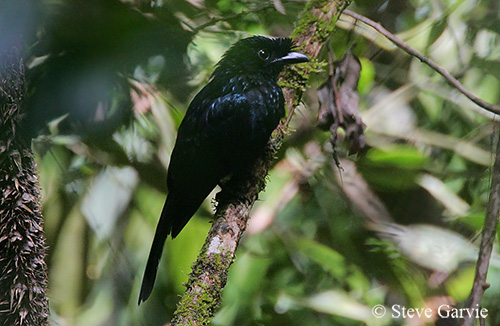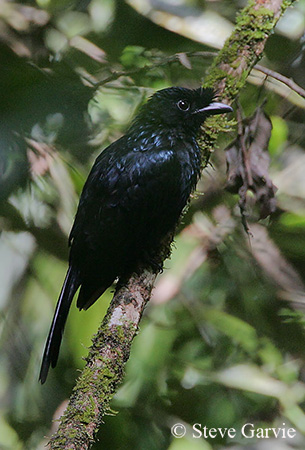
PROTECTION / THREATS / STATUS:
The Sri Lanka Drongo is threatened by habitat destruction and fragmentation caused by deforestation, human settlements and agricultural expansion.
Conservation efforts are needed to protect this species described as locally common to uncommon.
The size of the population is unknown.
But currently, the Sri Lanka Drongo is evaluated as Least Concern.
Fr: Drongo drongup - Drongo du Sri Lanka
Ang: Sri Lanka Drongo
All: Regendrongo
Esp: Drongo Cingalés
Ita: Drongo del Paradiso
Nd: Ceylonese Kuifdrongo
Sd: ceylondrongo
Photographers:
Steve Garvie
RAINBIRDER Photo galleries
Alan & Ann Tate
AA Bird Photography
Text by Nicole Bouglouan
Sources:
HANDBOOK OF THE BIRDS OF THE WORLD Vol 14 by Josep del Hoyo-Andrew Elliot-David Christie - Lynx Edicions – ISBN: 9788496553507
Birds of Sri Lanka De Deepal Warakagoda, Uditha Hettige, Himesha Warakagoda – Editor: Bloomsbury Publishing, 2022 – ISBN: 1472993861, 9781472993861 – 244 pages
Host tree canopy isolation by nesting Sri Lanka Drongo Dicrurus lophorinus
Sri Lanka Drongo – A Versatile Bird
Earth Lanka - A New Behavior Recorded On Sri Lankan Drongo
Fascinating nesting behavior of Sri Lanka Crested Drongo
Fatbirder - The World’s Richest Information Resource about Birds for Birders
CREAGUS@Monterey Bay (Don Roberson)
Wikipedia, the free encyclopaedia
Home page
Page Passeriforme Order
Sri Lanka Drongo
Dicrurus lophorinus
Passeriformes Order – Dicruridae Family
INTRODUCTION:
The Sri Lanka Drongo is endemic to Sri Lanka. It is found in the wet zone and nearby hills of the SW of the island.
This medium-sized bird has glossy black plumage and a long, forked tail. Very noisy, it is known to mimic the songs of other bird species. It feeds on insects caught in the air by hawking, and it is often seen foraging in groups.
During the breeding season, the Sri Lanka Drongo shows peculiar behaviour during the nest-building period. The cup-shaped nest is built in tree, and the species protects the nest-site from predators by eliminating part of the vegetation that helps snakes and small mammals to reach the nest and the chicks. The canopy foliage between the nest-site and the adjacent trees is removed by breaking off and destroying the vegetal part too close to the nest, making the habitat safe for nesting and rearing the young.
The Sri Lanka Drongo is aggressive and able to mobs and chase large predators such as Birds of Prey and hornbills.
The Sri Lanka Drongo has a restricted range in which it is described as locally common to uncommon. The species is not globally threatened at the moment.
DESCRIPTION OF THE BIRD:
Biometrics:
Length: 31-34 cm (excluding the tail of 16-20 cm)
Weight: 65-70 gr
The Sri Lanka Drongo has predominantly black plumage with metallic blue or greenish-blue gloss except on most of underparts where throat, upper breast, lower belly and flanks are less glossy. On the underwing, axillaries and underwing-coverts are tipped white.
The long tail (16-20 cm) is deeply forked. The outer rectrices are strongly curved upwards and inwards.

On the head, forehead and frontal tuft are deep velvety black. The frontal tuft resembles a short, bushy, stiff crest. The longest feathers curve over the forehead.
The black bill is hooked. We can see fairly long rictal bristles on each sides of the bill base.
The eyes are brown to reddish-brown.
Legs and feet are black.
Male and female are similar.
The juvenile has duller plumage overall. The belly is greyer and shows whitish scaling. Axillaries and underwing-coverts show larger white tips.
The crest is smaller.
RANGE:
The Sri Lanka Drongo is endemic to Sri Lanka and occurs in the SW of the island, from R Deduru Oya (in N) S to R Walawe (in SW). It is mainly found in the wet zone.
HABITAT:
The Sri Lanka Drongo is found locally in the wet zone of the island, up to the nearby hills, between 300 and 1,200 metres of elevation. But the species is also reported up to 1,700 metres on Adam’s Peak (2,243 metres).
It generally frequents the tall, humid forests, woodlands and well-wooded gardens.
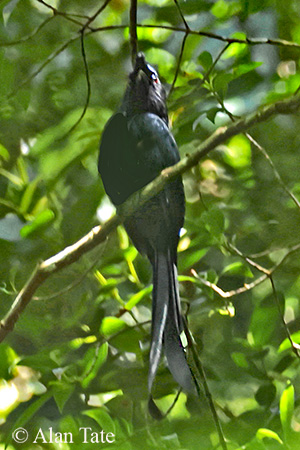
CALLS AND SONGS: SOUNDS BY XENO-CANTO
The Sri Lanka Drongo is described as “very noisy” and it is known to produce impressive vocalizations.
The song is a mixture of loud whistles, bell-like sounds, squeaky calls, fluty or sweet grinding notes and also harsh scolding. The harsh notes often alternate with softer sounds.
The calls include nasal, mechanical “urdle-eee” or quick “urd-lee” and a series of loud disyllabic or single twanging notes.
The Sri Lanka Drongo also mimics the calls of numerous rainforest bird species while perched in the open from where it attracts attention.
BEHAVIOUR IN THE WILD:
The Sri Lanka Drongo is typically insectivorous and is a very efficient hunter. The bird searches for prey from a prominent perch. Once a prey is detected, it sallies or darts out to catch large flying insects such as locusts, cicadas or beetles in the air. Then, it returns to the perch by diving back on closed wings.
Another technique is to glide down, sometimes pursuing a prey in flight, slaloming between trees and vegetation or hovering to reach smaller prey such as flies or bees.
The Sri Lanka Drongo is sociable, and several pairs often forage together and with other forest birds.
They have been observed performing “anting” during which the bird rubs ants on its plumage to remove parasites.
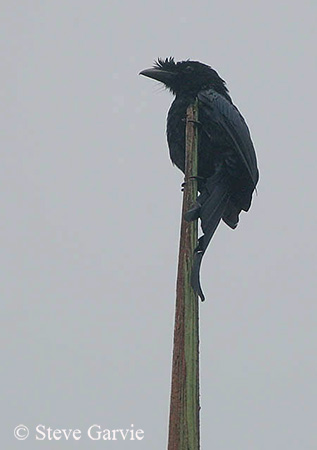
The Sri Lanka Drongo is monogamous and highly territorial. They live in pairs all year round and the pair bond is strong. The territory and especially the area around the nest are aggressively defended against predators.
The courtship displays of this species are not described, but usually, the drongos give scolding notes while raising the head and the foreparts of the body, moving the bill up and down while fluttering the wings from time to time. We can also suggest that the head tuft plays a role during the displays.
But the Sri Lanka Drongo is also known for its peculiar nesting behaviour. The nest is built in isolated tree in forest opening, and the same tree is reused in several following years.
But in order to protect the nest and the chicks, the adults clean the vegetation around the site by tearing and stripping leaves from the nesting tree, but also from the adjacent trees. In the same way, loose bark and epiphytes are removed from the trunk of the nesting tree.
At the end of this work, the canopy of the host tree does not touch those of the close trees. The trunk of the host tree is also cleaned between the point where it emerges from the undergrowth and the first branches.
The aim of these changes is to prevent snakes and small mammals to jump across the nesting tree. Usually, the distance between the canopies of host tree and adjacent trees seems to be just out their jumping range.
If humans approach the nest site after the laying, the bird mobs them and uses both raptor and macaque alarm mimicry.
The drongos are very busy in both morning and evening hours.
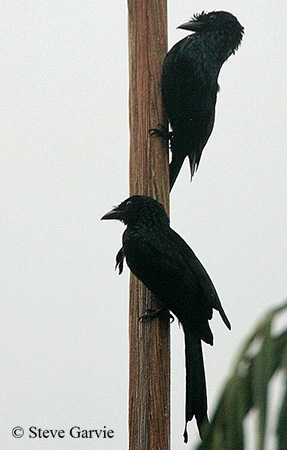
The Sri Lanka Drongo is resident within the restricted range.
The flight is described as acrobatic, especially during the foraging period. The bird dives from the perch, pursues the prey, sallies and darts out to catch insects in the air and hovers after smaller insects.
REPRODUCTION OF THIS SPECIES:
The breeding season takes place from March to May, with peak in April.
The Sri Lanka Drongo builds a cup-shaped nest on open branch or fork in isolated tall tree. The site is cleaned to avoid attacks by predators (see above “Behaviour in the wild”). The flimsy structure is made of grass, roots and vegetal fibres. Spider webs maintain the materials together. The nest is rather small for the size of this species. It is placed 6-7,5 metres above the ground in tall tree.
The female lays 2-4, usually 3 whitish to salmon-pink eggs with pale lavender markings, more numerous on the large end.
Duration of incubation and nestling periods are unknown. The young generally remain in the parental territory until at least the next breeding season, when they are chased by their parents. Both adults share the nesting duties.
No more information.
